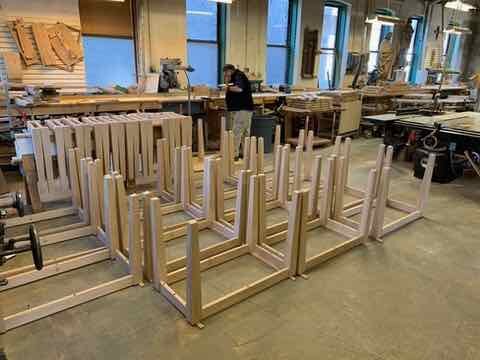What's a Woodshop Without Wood?
[This blog post is adapted from John Geissler’s article, “Tending Oaks for 2258,” in the Winter 2017-2018 Abbey Banner, p. 14.]
For more than 160 years, the land surrounding Saint John’s Abbey has been shaped by the work, prayer, and long term vision of the monastic community here in Collegeville. The Abbey Arboretum’s unique convergence of prairie, oak savanna, northern hardwoods, conifers, lakes, wetlands, and bogs are genuinely special and inspirational for those who both recognize and experience it.
Perhaps the most significant component of the Arboretum’s woods is its sweeping oak forest. Red and white oak cover nearly 700 acres and provide a rich habitat for a wide range of species and ecosystems. Unknown to many, these woods provide a steady flow of high-quality, sustainably harvested hardwood which is proudly used by Abbey Woodworking to craft furniture for campus and beyond. And almost all of the Woodshop’s pieces began as seedlings in the various hardwood forests of the Abbey Arboretum.
As the land manager of the Abbey Arboretum, John Geissler works diligently to prepare its forests to be resilient as stresses like climate change, invasive insects, and diseases inevitably appear. John notes, “A forest’s resilience comes from diversifying its age, structure, and, ultimately, its full biodiversity. The Arboretum’s greatest weakness is a lack of the diversity of its age classes, particularly a lack of young stands of oak. To address this problem, efforts are being made to regenerate red and white oak seedlings on plots of five acres annually. Regeneration is challenging and involves the protection of red and white oak seedlings from deer and understory competition for a number of years until they exceed six feet in height.”
John reminds us that oak trees are a shade-intolerant species that require “disturbance” to become established. Since fire has been removed as the forest’s natural “disturber in chief,” John mimics this disturbance with planned timber harvests and brush cutting to keep sun-loving species like oak as a vital component of the forest. Without these labor-intensive efforts, the Arboretum would lose biodiversity, as oak would continue to diminish, and shade-tolerant species, such as maple and basswood, would become more and more prevalent.
Over the decades, the Abbey Arboretum has found success in opening the forest canopy with shelterwood harvests; these harvests allow the sunlight to penetrate closer to the ground so as to regenerate oak seedlings. However, few oak seedlings grow into saplings because of the heavy deer browsing. So in an attempt to limit the destructive deer browse, the Abbey Arboretum continues to host regular archery deer hunt to increase the annual harvest of deer. Regrettably, these efforts by themselves rarely succeed in central Minnesota, as the deer population is now too large for effective management.
Consequently, John and his team have turned to the use of both deer exclosures (fenced acres of up to 20 acres within the forest) and individual tree fence shelters to isolate growing seedlings and saplings from deer. Additionally, the placement of matting around seedlings helps to assure that needed sunlight will filter down to the them as they mature. John reports that, “In the past 3 years we have matted and protected an astonishing 4000 oak trees on just over 14 acres. This labor-intensive work could not have been accomplished without a truly remarkable Abbey Conservation Corps volunteer force of monks and dozens of college and prep school students, alumni, and community members. The hard work is beginning to pay off as young oaks are gaining 1-2 feet of growth annually with their newfound growing space. We hope to continue this work on 5 acres annually to build a more resilient and diverse forest. With our current acreage of oak, this would create an approximate 100-year rotation with a spectrum of age classes from 1- year-old to the 200-300-year-old trees left in designated old growth stands.”
As you can imagine, it takes an intense effort to assure the availability of the red and white oak that is core to the furniture found throughout Saint John’s. Absent these efforts, Abbey Woodworking would lose the thing that makes our furniture unique: its wood.
For more information about our wood and landscape, follow the links below:
Forest Stewardship
The Landscape
Land Stewardship Volunteer Opportunities
On Saturday May 9 2020, join John and those interested in stewardship of the land to plant, mat, and cage 1200 red and white oak trees on 5 acres of the Abbey Arboretum.
Those interested in contributing time, talent, or treasure to this or other land stewardship adventures that will benefit the present and future abbey arboretum should contact Mr. John Geissler. Phone: 320.363.3126; email: jgeissler001@csbsju.edu; online. For most jobs, experience is not required, but enthusiasm and an interest in the environment definitely are!















